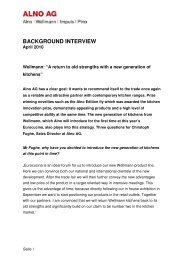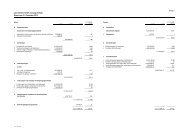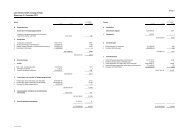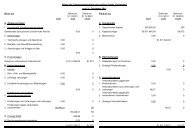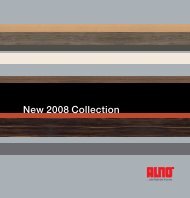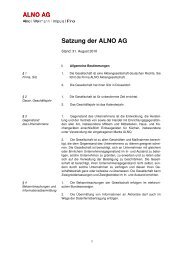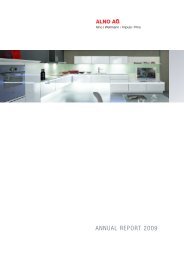100 % FUTURE - ALNO
100 % FUTURE - ALNO
100 % FUTURE - ALNO
You also want an ePaper? Increase the reach of your titles
YUMPU automatically turns print PDFs into web optimized ePapers that Google loves.
<strong>100</strong><br />
The carrying amount of deferred tax assets is reviewed at every reporting date, and reduced to the<br />
extent to which it is no longer likely that an adequate taxable profit will be available against which<br />
the deferred tax asset can at least be partially offset. Deferred tax assets that are not recognized<br />
on the balance sheet are reviewed at every reporting date, and recognized to the extent to which<br />
it has become likely that a future taxable profit will enable the deferred tax asset to be realized.<br />
Deferred tax assets and liabilities are netted if the conditions for netting tax liabilities with tax<br />
receivables apply.<br />
In addition, no deferred tax assets and liabilities are recognized if they result from the initial recognition<br />
of goodwill, an asset, or a liability, as part of a business transaction that is not a business<br />
combination, and if this initial recognition impacts neither the accounting result before income taxes<br />
nor taxable earnings.<br />
Deferred taxes relating to items posted directly to equity are recognized in equity, and not in the<br />
income statement.<br />
Value added tax<br />
Income, expenses, intangible assets, and property, plant and equipment are recorded after VAT has<br />
been deducted, to the extent that VAT is recoverable from a tax authority. Receivables and liabilities<br />
are recognized including VAT. Provisions are carried without taking VAT into account.<br />
The amount of VAT to be refunded by a tax authority, or which is to be paid to a tax authority, is<br />
carried under other assets or liabilities.<br />
Intangible assets<br />
Acquired and internally generated intangible assets are capitalized at cost according to IAS 38 if it<br />
is likely that their use will result in future economic benefits, and if it is possible to reliably estimate<br />
the costs of the asset.<br />
The cost of intangible assets solely comprises directly allocable costs.<br />
With regard to the accounting for, and measurement of, goodwill, please refer to our comments on<br />
consolidation methods, and the information in the section “Impairment testing for goodwill”.<br />
Other intangible assets, mostly software and other industrial property rights, are carried at cost, and<br />
are subjected to amortization over a useful life of between two and ten years.<br />
Research costs and non-capitalized development costs are carried as expenses on the date on<br />
which they arise.<br />
Intangible assets are either derecognized on disposal, or at the date when economic benefit is no<br />
longer expected from the continued use or sale of the asset. The gains or losses resulting from<br />
the disposal of the asset are calculated as the difference between the net realizable value and the<br />
carrying amount of the asset, and are recognized in income in the consolidated income statement<br />
in the period in which the asset is derecognized.





